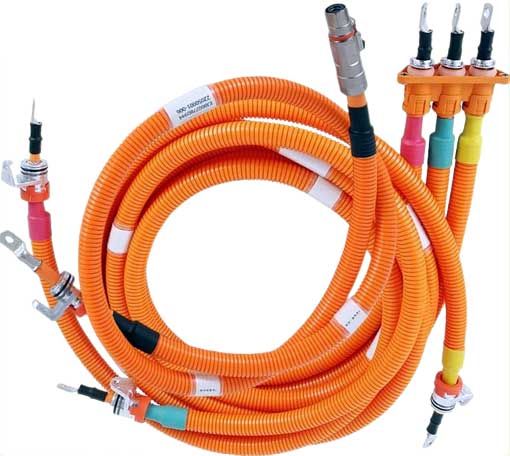κατηγορίες προϊόντων
Ετικέτες προϊόντων
EV / HV high voltage wiring harness for Battery Packs
EV / HV high voltage wiring harness Conductors can be divided into single-core conductors and multi-core conductors according to process characteristics. The difference is that multi-core wires are made up of multiple single-core wires. In essence, the electrical performance parameters and structural size parameters of each single-core wire are no different from those of single-core conductors. If the multi-core cable is used for signal transmission, separate shielding measures need to be taken to ensure that the signal is not lost.
EV / HV High voltage wiring harness range: Power battery PACK, energy storage battery PACK, telecom base station energy storage PACK.
High voltage wiring harness features:
Ensure a tight crimp on the wire harness with perfect crimp points.
Meet the pulling force requirements, safe and reliable.
Low temperature rise and high consistency.
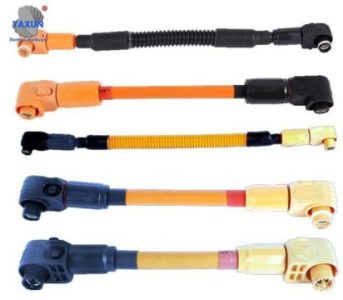
High voltage connectors and wiring harnesses
Classification of high voltage wires:
Conductors can be divided into single-core conductors and multi-core conductors according to process characteristics. The difference is that multi-core wires are made up of multiple single-core wires. In essence, the electrical performance parameters and structural size parameters of each single-core wire are no different from those of single-core conductors. If the multi-core cable is used for signal transmission, separate shielding measures need to be taken to ensure that the signal is not lost.

Figure-Multi-core shielded high-voltage cable

Figure-Single-core shielded high-voltage cable

Single core shielded high voltage cable

Single core unshielded high voltage cable
High-voltage conductors can also be divided into unshielded conductors and shielded conductors according to whether they have a shielding layer.
In addition to the four combinations of single-core shielded wires, single-core unshielded high-voltage wires, multi-core shielded high-voltage wires, and multi-core unshielded high-voltage wires, high-voltage wires can also be classified according to the following characteristics.
The composition of high-voltage wires:
Dissect the high-voltage wire from outside to inside, and you can see the following structural diagram.
High-voltage conductors are composed of secondary sheath (also called outer insulation), aluminum foil, shielding braid, inner insulation and core wire (conductor).
For industry standards, please refer to “QC-T1037 Automotive Industry Standard for High-voltage Cables for Road Vehicles” and “TCAS 356-2019 for High-voltage Cables for New Energy Vehicles”.
Some high-voltage conductors have a layer of tape between the shield and secondary sheath. The purpose of the wrapping tape is to facilitate the stripping of the insulation layer when producing crimped terminals. A material similar to non-woven fabric is wrapped around the wire and plays a certain isolation role.
The main structural size parameters of high-voltage conductors also revolve around these layers of materials, including the outer diameter of the secondary sheath, the diameter of the inner insulation layer, the diameter of the conductor, the diameter of a single copper wire, the number of copper wires, και τα λοιπά.
The function of high-voltage wire insulation layer:
(1) Insulation: Prevent the core wire from contacting other external conductors, causing a short circuit.
(2) Protect the core wire: prevent the internal wire core from being abraded by liquid and external devices.
(3) IP protection: including dustproof, αδιάβροχος, and touch-proof (human body protection).
(4) Parts arrangement: Provide a certain degree of flexibility for the high-voltage wire harness to facilitate the arrangement of the high-voltage wire harness on the vehicle body.
(5) Anti-scratch, flame retardant, και τα λοιπά. play special roles in weather resistance and reliability.
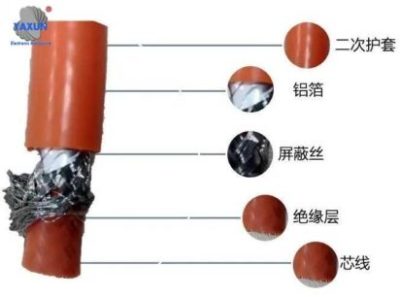
Anatomy of high voltage cable
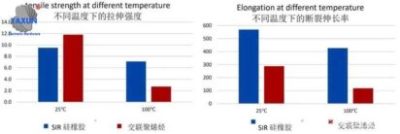
Figure – Tensile strength and breaking elongation of SIR silicone rubber cable at different temperatures

Figure – Mechanical strength and tear strength of SIR silicone rubber cable at different temperature
High-voltage wire insulation layer material properties:
Unlike low-voltage wires that only have an outer insulation layer, high-voltage wires have two layers of insulation, both inner and outer. The outer insulation layer is also often referred to as secondary sheathing. The materials for manufacturing the inner and outer insulation layers generally include XLPO (cross-linked polyolefin), SIR (silicone rubber) and TPE (thermoplastic elastomer).
Combining the characteristics comparison table of the above three materials, we can draw the differences between the three materials at the application level:
XLPO has a wide range of applications, and the parts in contact with the motor have a weak service life. TPE materials are mostly suitable for large-sized wires and communication wires.
In addition to the above characteristics, SIR silicone rubber also has good sealing properties. Under high temperature and high pressure, the deformation amount is small, and it is suitable for occasions that require high temperature resistance, small installation space, and small bending radius. As an insulating layer material for high-voltage wires in electric vehicles, it is perfect.
The function of high-voltage wire shielding layer:
High-voltage cables for electric vehicles bear higher voltages (rated voltage up to 600V), larger currents (rated current up to 600A), and strong electromagnetic radiation. Although high-voltage wires themselves do not produce large electromagnetic interference, the coupling voltage and coupling current of the wires basically come from the terminals connected to the wires, that is, high-voltage electrical appliances.
Electromagnetic interference is concentrated at both ends of the wire, that is, at the crimping point of the terminal. Επομένως, most of the current high-voltage conductors are designed with shielding structures to resist electromagnetic interference. It adopts a coaxial structure and utilizes the joint action of the inner conductor and the outer conductor (shielding layer). The magnetic field within the wire is distributed in concentric circles, while the electric field is directed from the inner conductor to the outer conductor, making the external electromagnetic field around the cable zero. That is to say, it shields electromagnetic radiation and eliminates the coupling voltage and coupling current in this area.
In the electromagnetic compatibility (EMC) test of the entire vehicle, high-voltage wiring harness parts need to meet the requirements of ISO 14572, with transfer impedance ≤31mΩ/m and shielding attenuation ≥70dB to meet the EMC requirements of the entire vehicle.
The high-voltage wire shielding layer is divided into a shielding wire braided layer and an aluminum foil layer. The conventional shielding layer structures are:
①Only shielding wire braid
② Shielding wire braid (close to the inner insulation layer) + aluminum foil layer (close to the outer insulation layer)
③Three states: aluminum foil layer (close to the inner insulation layer) + shielding wire braiding layer (close to the outer insulation layer).
Of course, some high-voltage conductors use braided mesh, aluminum tubes, or a combination of the two to directly cover the outer layer of the cable to provide EMC protection for the conductors.
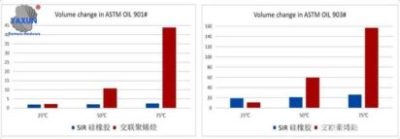
Volume change rate of oil resistance test of SIR silicone rubber cable in different oil products

Performance of SIR silicone rubber cable in 200 ℃, 3000 hours aging test
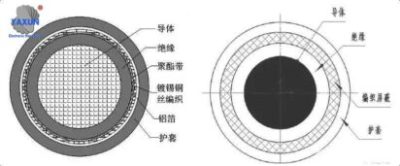
High-voltage cables are composed of two different forms of shielding layers
Επικοινωνήστε μαζί μας
Αναμονή για το email σας, θα σας απαντήσουμε εντός 12 ώρες με πολύτιμες πληροφορίες που χρειαζόσουν.
 English
English العربية
العربية Български
Български 中文(漢字)
中文(漢字) Čeština
Čeština Dansk
Dansk Eesti keel
Eesti keel Suomi
Suomi Français
Français Deutsch
Deutsch Ελληνικά
Ελληνικά עברית
עברית Magyar
Magyar Bahasa Indonesia
Bahasa Indonesia Italiano
Italiano 日本語
日本語 한국어
한국어 Latīna
Latīna Latviešu valoda
Latviešu valoda Lëtzebuergesch
Lëtzebuergesch Polski
Polski Português
Português Română
Română Русский
Русский Slovenščina
Slovenščina Español
Español Svenska
Svenska ภาษาไทย
ภาษาไทย Tiếng Việt
Tiếng Việt
